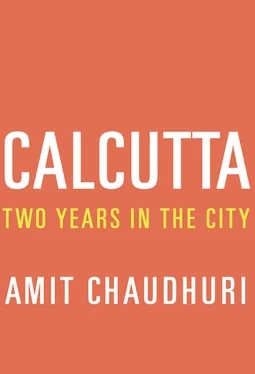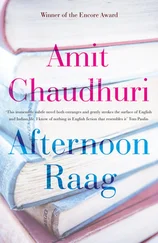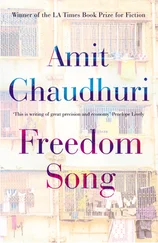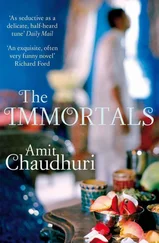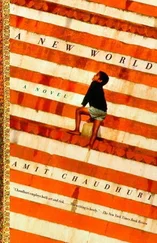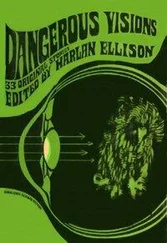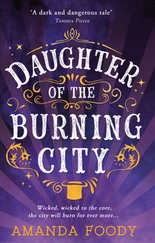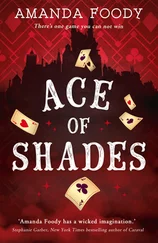I didn’t care much for this kind of twilit pre-Raphaelite or Orientalist scene — I hadn’t decided which it was; whether the river was a tributary of the Ganges or a stream in Scotland or England — which is why I’d avoided looking at it carefully. It might have been done by a relative, or even a friend. But Samirda recently told me that the painting was a picture in the manner of van Ruisdaal, except that the signature was missing — which is why a benefactor called Amber Patra bought it for only 40,000 rupees. Who is van Ruisdaal? A seventeenth-century Dutch painter, he was well known for his wooded landscapes and his clouds. As I look at his paintings, while they appear, one by one, on the Net, restored to a strange newness and clarity, I think I like his work; it isn’t romantic, but worldly and precise — the clouds and woods and details are very real and still. A patina must have darkened the picture in Samirda’s drawing room, obscuring its colours and bringing to it that twilit, Orientalist mood — which eventually dampens my spirits, and which is maybe why I’d never acknowledged it.
There were other things the Mukherjees sold at the time that I had no idea of. For instance, a golden fob watch that he recounts to me suddenly in a conversation, when I’m asking him about the painting. “And, oh yes, there was a fob watch,” he says; and this is the last item in the inventory he’s made for me, before I hastily ask him to stop — I don’t want to know more.
They’d also sold a marble table to a lady I know slightly, a vivacious socialite. Samirda, inexplicably, begins to chortle; he can’t help finding the ups and downs of existence entertaining. I’d heard once that the socialite herself was now in straitened circumstances, but this may be no more than the pointless gossip that circulates among a very small set of people in the city.
However, I do know that Anitadi wanted to rid herself of a necklace. She brought it out into the drawing room, and showed it to R and me: I recall the moment, and seeing the ornament, but have absolutely no recollection of what it looks like. Anitadi describes it as a “Victorian necklace”; R thinks of it, for some reason, as an “Edwardian knot,” as a piece of jewellery belonging to and devised in the twenties or thirties. It was a long, long thing, strung with pearls, says R, ending in a knot, from which two short tassels hung. It wasn’t the sort of jewellery that she would wear — strange and impractical, despite being beautiful. Besides, it was probably too expensive. What sort of social gatherings would she have worn it to?
Whether Anitadi inherited this from her mother-in-law or from the Anglo-Indian side of her family I haven’t asked. It doesn’t require pointing out that it wasn’t a piece of traditional Indian jewellery. Firstly, the Indian woman prefers gold to any other precious metal or stone, except possibly the diamond. However, the Ingabanga had internalised, and paid homage to, the English ethos in a number of ways, including their taste in certain strains of jewellery. In the history of Indian jewellery — a history of longevity and continuity — the English ethos is a fleeting, almost momentary, interruption, and as good as a secret, since so few adhered to it. The Ingabanga, in that interim, went off the colour of high-carat gold, and even had it mixed with alloy for their ornaments, to dull their yellow gleam. What R calls “blue-blooded Bengalis” would find this dilution outrageous, and another symptom of the ridiculousness of the Ingabanga world.
Among the ornaments my wife was gifted by her family upon our wedding was a gold bangle inherited from her tennis-playing maternal grandmother, Anila. My mother offered to have the bangle “broken” and redesigned by a jeweller: a common enough practice, where the Bengali will take an old piece to their jeweller and, instead of selling or exchanging it, will have it rejuvenated or updated to another form. R was, naturally, sentimental about the bangle; but, newly married, she was too polite to say no to this helpful suggestion. The bangle itself was a curious mixture of East and West, of the Bengali and the English, and was a perfect material example of the notion of the Ingabanga. Its circular body was made according to the traditional style of the “ lichukata bala ,” the “litchi-cut bangle,” so that tiny bristles like the ones on a litchi peel appeared on the gold. At one place on the bangle there was an embossed carving — the head of a dog. It was a Labrador with drooping ears. Beneath my mother’s helpful offer perhaps lay a disguised animosity towards the Labrador. And it was the dog, which R found absurd, which she in retrospect grew attached to — as a symbol of a history that may have been embarrassing, but was precious because of its short-lived uniqueness. “Should I ask him to remove the dog?” asked my mother. “You’ll never wear a bangle with a dog’s face, will you?” R appeared to agree. The agreement was only an instance of confusion and letting go. The Labrador disintegrated, and was replaced by a peacock, but the rest of the bangle returned intact.
The Mukherjees sold the Victorian necklace or Edwardian knot or whatever it was for one lakh rupees. Anitadi, at the time, was detached and rational about it — as she is about many things. “What’ll I do with it? I’ll never wear it,” she’d said reasonably. “One lakh is a good price, baba,” says Samirda to me today. A moment later, he’s not so sure: “Or who knows? Maybe it’s not a good price. I never knew that much about money”—chortling again with pleasure. Ah, but he had his perfect spoken English, after all, his elocution. Where would he and his family have been without it? The conversation veers towards a subject seldom broached — his younger brother Prabir, who’s been living in Spain for decades. “He was much cleverer than me. Did better than I did at Cambridge.” As in? “He got a 2:2 in economics.” A 2:2—so not so much better, then. “I got a third — a matter of shame. It was because I never liked economics and never understood it.”
The apartment on the upper storey was Prabir’s. Yet Mrs. Mukherjee, in the late seventies, had asked her younger son to give her the flat so she could rent it out for a supplementary income. (The house, of course, was hers.) This had caused bad blood between her and the — if not estranged, then distant and distanced — younger son.
A Marwari family lived upstairs and paid a static, meagre rent. When I’d said to Samirda that selling the house would be a panacea to his problems — of all things that come to the rescue of the Bengali middle and upper classes, inherited property is the most commonly invoked, and the most effective solution — he’d said, “But there’s a garden at the back, baba. I go for walks in the morning with Anita. There’s a mango tree there, and wonderful birdcall. I don’t know what I’d do without it.” Samirda’s letters to the editor and to his friends were always fulsome and often lyrical, and so was his endorsement of this back garden. He also cited, as an obstacle to the sale of the house, the litigation with the charitable organisation; and, of course, the troublesome Marwaris upstairs.
Nevertheless, the house was sold in 2006 to a property developer for a sizeable sum. This wasn’t surprising, given that property prices were going up and up in Calcutta in the new millennium, and given the house’s location on Lower Circular Road.
The Mukherjees — Anita and Samir — now live in a posh apartment building called Balaka on Ballygunge Circular Road. Mrs. Mukherjee Senior died only a few months after the move. She was ninety-five.
I’ve always liked these apartments. The building came up in the mid-seventies, almost opposite the erstwhile Tivoli Park (still, then, extant, with the Mukherjees occupying a “cottage”), a belated, elegant gesture towards corporate living in a city, by then, largely without corporations. One of my father’s colleagues lived in the building for a while; I remember visiting his son there in the early eighties, and taking in the magnificent view from the ninth-floor balcony — magnificent not because it was scenic, but marvelling at the city’s intricacy and difficulty, its distant humming and beeping, its various shades of brown and grey, its sudden stretches of green, its splendid, still, leaden sky, all revealed from left to right before darkness came. I loved Balaka for the smartness of its apartments and for its view; but I had no premonition that I’d one day enter it again.
Читать дальше
